There are lots of important and exciting years that people like to talk about when it comes to the history of nuclear weapons. 1945 obviously gets pride of place, being the year of the first nuclear explosion ever (Trinity), the first and only uses of the weapons in war (Hiroshima and Nagasaki), and the end of World War II (and thus the beginning of the postwar world). 1962 gets brought up because of the Cuban Missile Crisis. 1983 has been making a resurgence in our nuclear consciousness, thanks to lots of renewed interest in the Able-Archer war scare. All of these dates are, of course, super important.
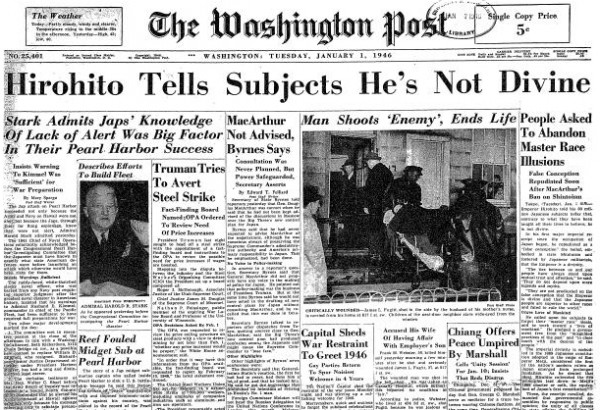
But one of my favorite historical years is 1946. It’s easy to overlook — while there are some important individual events that happen, none of them are as cataclysmic as some of the events of the aforementioned years, or even some of the other important big years. But, as I was reminded last week while going through some of the papers of David Lilienthal and Bernard Baruch that were in the Princeton University archives, 1946 was something special in and of itself. It is not the big events that define 1946, but the fact that it was a liminal year, a transition period between two orders. For policymakers in the United States, 1946 was when the question of “what will the country’s attitude towards the bomb be?” was still completely up for grabs, but over the course of the year, things became more set in stone.
1946 was a brief period when anything seemed possible. When nothing had yet calcified. The postwar situation was still fluid, and the American approach towards the bomb still unclear.
Part of the reason for this is because things went a little off the rails in 1945. The bombs were dropped, the war had ended, people were pretty happy about all of that. General Groves et al. assumed that Congress would basically take their recommendations for how the bomb should be regarded in the postwar (by passing the May-Johnson Bill, which military lawyers, with help from Vannevar Bush and James Conant, drafted in the final weeks of World War II). At first, it looked like this was going to happen — after all, didn’t Groves “succeed” during the war? But in the waning months of 1945, this consensus rapidly deteriorated. The atomic scientists on the Manhattan Project who had been dissatisfied with the Army turned out to make a formidable lobby, and they found allies amongst a number of Senators. Most important of these was first-term Senator Brien McMahon, who quickly saw an opportunity to jump into the limelight by making atomic energy his issue. By the end of the year, not only did Congressional support fall flat for the Army’s Bill, but even Truman had withdrawn support for it. In its place, McMahon suggested a bill that looked like something the scientists would have written — a much freer, less secret, civilian-run plan for atomic energy.
So what happened in 1946? Let’s just jot off a few of the big things I have in mind.
January: The United Nations meets for the first time. Kind of a big deal. The UN Atomic Energy Commission is created to sort out questions about the future of nuclear technology on a global scale. Hearings on the McMahon Bill continue in Congress through February.
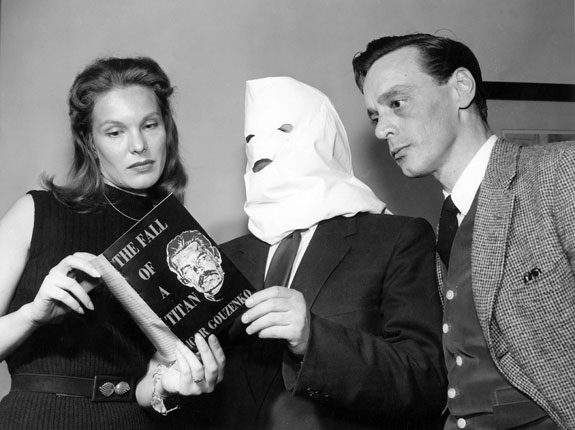
Igor Gouzenko (masked) promoting a novel in 1954. The mask was to help him maintain his anonymity, but you have to admit it adds a wonderfully surreal and theatrical aspect to the whole thing.
February: The first Soviet atomic spy ring is made public when General Groves leaks information about Igor Gouzenko to the press. Groves wasn’t himself too concerned about it — it was only a Canadian spy ring, and Groves had compartmentalized the Canadians out of anything he considered really important — but it served the nice purpose of dashing the anti-secrecy lobby onto the rocks.
Also in February, George F. Kennan sends his famous “Long Telegram” from Moscow, arguing that the Soviet Union sees itself in essential, permanent conflict with the West and is not likely to liberalize anytime soon. Kennan argues that containment of the USSR through “strong resistance” is the only viable course for the United States.
March: The Manhattan Engineer District’s Declassification Organization starts full operation. Groves had asked the top Manhattan Project scientists to come up with the first declassification rules in November 1945, when he realized that Congress wasn’t going to be passing legislation as soon as he expected. They came up with the first declassification procedures and the first declassification guides, inaugurating the first systematic approach to deciding what was secret and what was not.
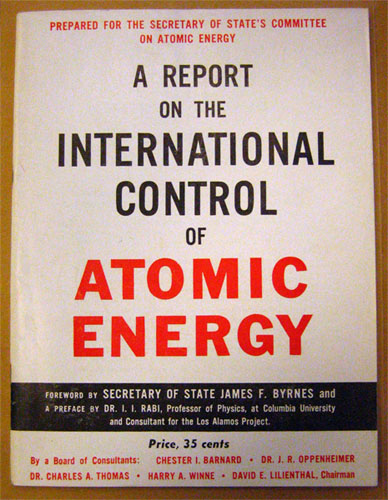
Lilienthal’s own copy of the mass-market edition of the Acheson-Lilienthal Report, from the Princeton University Archives.
March: The Acheson-Lilienthal Report is completed and submitted, in secret, to the State Department. It is quickly leaked and then was followed up by a legitimate publication by the State Department. Created by a sub-committee of advisors, headed by TVA Chairman David Lilienthal and with technical advice provided by J. Robert Oppenheimer, the Acheson-Lilienthal Report argued that the only way to a safe world was through “international control” of atomic energy. The scheme they propose is that the United Nations create an organization (the Atomic Development Authority) that would be granted full control over world uranium stocks and would have the ability to inspect all facilities that used uranium in significant quantities. Peaceful applications of atomic energy would be permitted, but making nuclear weapons would not be. If one thought of it as the Nuclear Non-Proliferation Treaty, except without any authorized possession of nuclear weapons, one would not be too far off the mark. Of note is that it is an approach to controlling the bomb that is explicitly not about secrecy, but about physical control of materials. It is not loved by Truman and his more hawkish advisors (e.g. Secretary of State Byrnes), but because of its leak and subsequent publication under State Department header, it is understood to be “the” position of the United States government on the issue.
April: The McMahon Act gets substantial modifications while in committee, including the creation of a Military Liaison Committee (giving the military an official position in the running of the Atomic Energy Commission) and the introduction of a draconian secrecy provision (the “restricted data” concept that this blog takes its name from).
June: The Senate passes the McMahon Act. The House starts to debate it. Several changes are made to the House version of the bill — notably all employees with access to “restricted data” must now be investigated by the FBI and the penalty for misuse or espionage of “restricted data” is increased to death or life imprisonment. Both of these features were kept in the final version submitted to the President for signature in July.
June: Bernard Baruch, Truman’s appointee to head the US delegation of the UN Atomic Energy Commission, presents a modified form of the Acheson-Lilienthal Report to the UNAEC, dubbed the Baruch Plan. Some of the modifications are substantial, and are deeply resented by people like Oppenheimer who see them as torpedoing the plan. The Baruch Plan, for example, considered the question of what to do about violations of the agreement something that needed to be hashed out explicitly and well in advance. It also argued that the United States would not destroy its (still tiny) nuclear stockpile until the Soviet Union had proven it was not trying to build a bomb of their own. It was explicit about the need for full inspections of the USSR — a difficulty in an explicitly closed society — and stripped the UN Security Council of veto power when it came to enforcing violations of the treaty. The Soviets were, perhaps unsurprisingly, resistant to all of these measures. Andrei Gromyko proposes a counter-plan which, like the Baruch Plan, prohibits the manufacture and use of atomic weaponry. However, it requires full and immediate disarmament by the United States before anything else would go into effect, and excludes any international role in inspection or enforcement: states would self-regulate on this front.
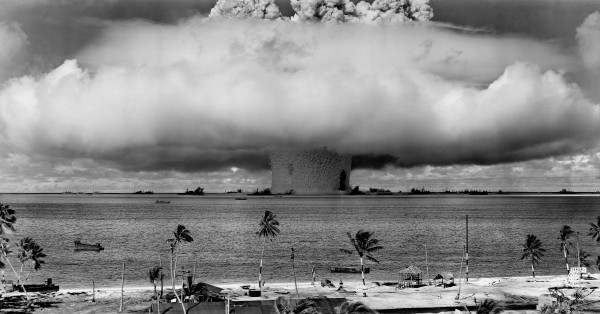
Shot “Baker” of Operation Crossroads — one of the more famous mushroom clouds of all time. Note that the mushroom cloud itself is not the wide cloud you see there (which is a brief condensation cloud caused by it being an underwater detonation), but is the more bulbous cloud you see peaking out of the top of that cloud. You can see the battleships used for target practice near base of the cloud. The dark mark on the right side of the stem may be an upturned USS Arkansas.
July: The first postwar nuclear test series, Operation Crossroads, begins in the Bikini Atoll, Marshall Islands. Now this is a curious event. Ostensibly the United States was in favor of getting rid of nuclear weapons, and in fact had not yet finalized its domestic legislation about the bomb. But at the same time, it planned to set off three of them, to see their effect on naval vessels. (They decided to only set off two, in the end.) The bombs were themselves still secret, of course, but it was decided that this event should be open to the world and its press. Even the Soviets were invited! As one contemporary report summed up:
The unique nature of the operation was inherent not only in its huge size — the huge numbers of participating personnel, and the huge amounts of test equipment and number of instruments involved — it was inherent also in the tremendous glare of publicity to which the tests were exposed, and above all the the extraordinary fact that the weapons whose performance was exposed to this publicity were still classified, secret, weapons, which had never even been seen except by a few men in the inner circles of the Manhattan District and by those who had assisted in the three previous atomic bomb detonations. It has been truly said that the operation was “the most observed, most photographed, most talked-of scientific test ever conducted.” Paradoxically, it may also be said that it was the most publicly advertised secret test ever conducted. 1
August: Truman signs the McMahon Act into law, and it becomes the Atomic Energy Act of 1946. It stipulates that a five-person Atomic Energy Commission will run all of the nation’s domestic atomic energy affairs, and while half of the law retains the “free and open” approach of the early McMahon Act, the other half has a very conservative and restrictive flavor to it, promising death and imprisonment to anyone who betrays atomic secrets. The paradox is explicit, McMahon explained at the time, because finding a way to implement policy between those two extremes would produce rational discussion. Right. Did I mention he was a first-term Senator? The Atomic Energy Commission would take over from the Manhattan Engineer District starting in 1947.
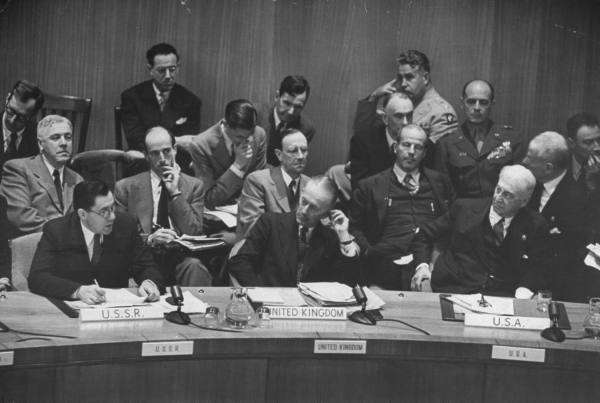
A meeting of the UN Atomic Energy Commission in October 1946. At front left, speaking, is Andrei Gromyko. Bernard Baruch is the white-haired man sitting at the table at right behind the “U.S.A” plaque. At far top-right of the photo is a pensive J. Robert Oppenheimer. Two people above Baruch, in the very back, is a bored-looking General Groves. Directly below Groves is Manhattan Project scientist Richard Tolman. British physicist James Chadwick sits directly behind the U.K. representative at the table.
September: Baruch tells Truman that international control of atomic energy seems nowhere in sight. The Soviet situation has soured dramatically over the course of the year. The Soviets’ international control plan, the Gromyko Plan, requires full faith in Stalin’s willingness to self-regulate. Stalin, for his part, is not willing to sign a pledge of disarmament and inspection while the United States is continuing to build nuclear weapons. It is clear to Baruch, and even to more liberal-minded observers like Oppenheimer, that the Soviets are probably not going to play ball on any of this, because it would not only require them to forswear a potentially important weapon, but because any true plan would require them to become a much more open society.
October: Truman appoints David Lilienthal as the Chairman of the Atomic Energy Commission. Lilienthal is enthusiastic about the job — a New Deal technocrat, he thinks that he can use his position to set up a fairly liberal approach to nuclear technology in the United States. He is quickly confronted by the fact that the atomic empire established by the Manhattan Engineer District has decayed appreciably in year after the end of the war, and that he has powerful enemies in Congress and in the military. His confirmation hearings start in early 1947, and are exceptionally acrimonious. I love Lilienthal as an historical figure, because he is an idealist who really wants to accomplish good things, but ends up doing almost the opposite of what he set out to do. To me this says a lot about the human condition.
November: The US Atomic Energy Commission meets for the first time in Oak Ridge, Tennessee. They adopt the declassification system of the Manhattan District, among other administrative matters.
December: Meredith Gardner, a cryptanalyst for the US Army Signal Intelligence Service, achieves a major breakthrough in decrypting wartime Soviet cables. A cable from 1944 contains a list of scientists working at Los Alamos — indications of a serious breach in wartime atomic security, potentially much worse than the Canadian spy ring. This information is kept extremely secret, however, as this work becomes a major component in the VENONA project, which (years later) leads to the discovery of Klaus Fuchs, Julius Rosenberg, and many other Soviet spies.
On Christmas Day, 1946, the Soviet Union’s first experimental reactor, F-1, goes critical for the first time.
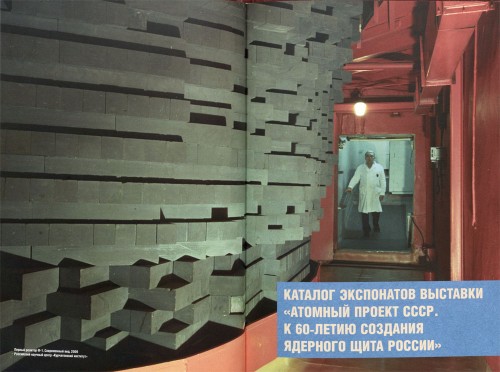
The Soviet F-1 reactor, in 2009. It remains operational today — the longest-lived nuclear reactor by far.
No single event on that list stands out as on par with Hiroshima, the Cuban Missile Crisis, or even the Berlin Crisis. But taken together, I think, the list makes a strong argument for the importance of 1946. When one reads the documents from this period, one gets this sense of a world in flux. On the one hand, you have people who are hoping that the re-ordering of the world after World War II will present an enormous opportunity for creating a more peaceful existence. The ideas of world government, of the banning of nuclear weapons, of openness and prosperity, seem seriously on the table. And not just by members of the liberal elite, mind you: even US Army Generals were supporting these kinds of positions! And yet, as the year wore on, the hopes began to fade. Harsher analysis began to prevail. Even the most optimistic observers started to see that the problems of the old order weren’t going away anytime soon, that no amount of good faith was going to get Stalin to play ball. Which is, I should say, not to put all of the onus on the Soviets, as intractable as they were, and as awful as Stalin was. One can imagine a Cold War that was less tense, less explicitly antagonistic, less dangerous, even with limitations that the existence of a ruler like Stalin imposed. But some of the more hopeful things seem, with reflection, like pure fantasy. This is Stalin we’re talking about, after all. Roosevelt might have been able to sweet talk him for awhile, but even that had its limits.
We now know, of course, that the Soviet Union was furiously trying to build its own atomic arsenal in secret during this entire period. We also know that the US military was explicitly expecting to rely on atomic weapons in any future conflict, in order to offset the massive Soviet conventional advantage that existed at the time. We know that there was extensive Soviet espionage in the US government and its atomic program, although not as extensive as fantasists like McCarthy thought. We also know, through hard experience, that questions of treaty violations and inspections didn’t go away over time — if anything, I think, the experience of the Nuclear Non-Proliferation Treaty has shown that many of Baruch’s controversial changes to the Acheson-Lilienthal Report were pretty astute, and quickly got to the center of the political difficulties that all arms control efforts present.
As an historian, I love periods of flux and of change. (As an individual, I know that living in “interesting times” can be pretty stressful!) I love looking at where old orders break down, and new orders emerge. The immediate postwar is one such period — where ideas were earnestly discussed that seemed utterly impossible only a few years later. Such periods provide little windows into “what might have been,” alternative futures and possibilities that never happened, while also reminding us of the forces that bent things to the path they eventually went on.
- Manhattan District History, Book VIII, Los Alamos Project (Y) – Volume 3, Auxiliary Activities, Chapter 8, Operation Crossroads (n.d., ca. 1946).[↩]


—Question: if you were someone living in India in 1946, and the biggest thing on your mind was getting the British Empire to leave, would you regard international control of Atomic Energy as
a.) An attempt by “them” to secure their Empires over subject peoples
b.) Something the world should embrace, because conflict with industrial age weapons was just so horrible.
c.) A good thing, because with *international control of Atomic Energy,* ex-Imperial areas could finally get economic progress without the yoke of the Imperial Masters.
d.) Too distant to worry about. Someday man will walk on the moon, too. But both Atomic Energy and man landings are too far away for us here in India to worry about.
My understanding is that the Indians did call for international control, formally, mostly for reasons b and c — they saw atomic war as too horrible to contemplate, and they saw atomic energy as a way for them to make a leap into economic progress. (Bhabha’s welcoming address to the 1955 Atoms for Peace conference lays out the argument of the latter very explicitly.)
Алекс, а вы владеете русским языком?
I can read it better than I can speak it. (Я могу читать лучше, чем я могу говорить.)
Great post – 1946 was a busy year, for sure. I’d add 1952 to the short-list of important years in nuclear history. The advent of thermonuclear weapons was a major turning point in nuclear strategy and nuclear politics.
—A question: I am sure, in theory, a secret can be kept by burning all the documents and having everyone die, of old age, or some other way.
—But—based on what we actually *know,* what secrets have either the US, or the UK, decided they can keep forever, in the sense that they will stay in the safe of the CIA director until the CIA is disbanded, and then in the safe of someone else in the government until the US government is disbanded.
—The original plans for the atomic bomb, and all US nuclear warheads afterwards, are probably scheduled to stay secret until all of the world’s weapons-uranium and plutonium is gone. And that is probably a good one hundred years from now, I suspect.
In principle, nothing is officially scheduled to stay secret “forever” — they just are supposed to stay secret as long as they are dangerous, or as long as keeping them secret makes more sense than not. As we’ve seen, this is something that can change over time. Implosion was initially in the “not to ever be declassified” category, but by 1951 the US decided it was better to declassify it (so they could use it as evidence against the Rosenbergs) than not. Obviously there is a spectrum of detail, from basic concept to specific implementation. But there is no hard-and-fast line there, it is always a somewhat subjective judgment. (There would be no reason, a priori, to suspect that they would have declassified in 2000 the statement that “the mass of plutonium in the Trinity test device and Fat Man was about 13½ pounds (6 kilograms),” or “The fact that the Trinity test device and Fat Man had 32 detonators with each detonator having two bridgewires that independently initiated the same point,” but they did.)
One paradoxical effect of the McMahon act was that it was a strong contributor to the UK’s decision to proceed with its own atomic bomb program. The passing of the act left the Labour Government of the day feeling let down by the Americans, and part of the decision to build their own bomb was to re-gain some influence over US nuclear policy. Some of the rhetoric coming out of Washington about pre-emptive attacks on the Soviet Union scared the hell of the Cabinet.
In fairness to McMahon, he was unaware in 1946 of the role the UK had played in the Manhattan Project, and later said that had he known the extent of the involvement and the agreements already in place on post-war co-operation he would not have framed the act as he did.
–Thought: Who were the domestic opponents of the McMahon act, and what were their arguments? More importantly, what arguments were made by Congressmen and Senators? Were any arguments made againt the McMahon act in print notably absent from the arguments of the legislators who voted against it?
—What if the strongest arguments againt the McMahon act were intentionally ignored by the legilators who were voted against it?
The biggest political detractors to the McMahon Act were those who thought it was too liberal, too lax on security. The April changes satisfied most of them (and satisfied the War Department). There were several in the House who wanted more wingnut things added to it (including the death penalty), but most of those changes were stripped out in the conference committee.
The largest arguments against it in print were mostly from the liberalizing side (Bulletin of the Atomic Scientist types); there were not too many legislators with that opinion by the time it came up for a vote.
I’ve always been curious how the McMahon Act went from being “science friendly” to something where the whole concept of “restricted data” was born. Do you have any info on how the April’s changes came about and why they weren’t fight like the earlier May-Johnson Bill?
I do — my book will have quite a lot on this. The short version is that the Gouzenko spy scare caused McMahon et al. to change their tune a bit, and the specific construction of the “Restricted Data” clause is the last of several awkward iterations that attempted to give the AEC the power to enforce secrecy but not to make things inherently secret. The law — which is to say, Congress — is what defines what the scope of nuclear secrecy can be, not the AEC. The AEC only has the power to declassify things, not classify them… because they are already inherently classified by the law. If that sounds like monstrously bad reasoning, I don’t disagree. It was an attempt to be too-clever-by-half with regards to secrecy and the result is a legal construction that is both difficult to enforce and interpret and is probably unconstitutional. (They were not thinking about privately-generated “Restricted Data” at the time because the McMahon Act gives the AEC an explicit monopoly over most nuclear technology, and because the situation on the ground was that it was already a de facto nationalized sector. Obviously within a decade that had changed.)
The reason there wasn’t any fight for it was because by that point the Scientists’ Movement had somewhat run out of steam and had fallen off the agenda, and the scientists just wanted something passed that did not put the military in charge of everything.
Well very much looking forward to your book, when is scheduled to come out?
I’m glad that you too find the whole “born secret but then declassify” monstrously bad reasoning, never understood how could people accept it. I mean, i’ve a soft spot for shock waves dynamics so i’ve red a bit about shaped charges mechanics and their history is mostly about the development of anti-armour warheads but it’s not classified even if they’ve been already used in terrorists attacks, and of course access to explosive is restricted and rightly so. So it’s difficult for me to understand the reasoning behind the idea that knowing like now we know that fat-man had an aluminium pusher to smooth r-tylor instabilities was a security risk, instead of relying on restricting the access to the actual hardware used to enrich uranium and so on.
Also, isn’t the technology for enrich U and processing Pu mostly declassified already?
As to when the book comes out, that’s the million dollar question — not too long, with any luck.
The main problem I have with the concept of RD is not so much the details about what is made secret or not — people can debate that — but the idea that everything in that arena is de facto secret unless explicitly declassified, and that nuclear secrets really need their own legally separate system from other forms of technical secrets.
The irony about the transition from the May-Johnson Bill to the McMahon Act is that the former’s provisions on secrecy were only that the AEC could make guidelines as to what was secret or not — that is, it gave them a little bit of a blank check, but the idea was that it would be no different than how the Army or the Navy make guidelines as to what is secret or not. They declare documents they produce secret, put a big stamp on them, and then they fall under the provisions of the Espionage Act. The McMahon Act originally had no secrecy provisions whatsoever, which the scientists liked, but then they tacked on a strange and purposefully contradictory special classification system that only applied to nuclear technology and nothing else. In that sense it ended up being much worse than May-Johnson, which just assumed that secrecy would be handled in the standard military fashion, not some kind of special new system cooked up just for the bomb.
On the enrichment and processing question — some of it is, some of it is not. The details of gaseous diffusion, for example, are still pretty classified. Some of the (old) methods for Pu processing are declassified, I don’t think the more modern and efficient ones are, though. Electromagnetic enrichment is basically declassified. Some aspects of the other main forms (gaseous and centrifugal) are declassified, though many details of specific systems are not.
Thanks for the explainations, i agree 100% with you on the absurdity of the “de facto secret” idead behind RD. The history of the McMahon Act is fascinating even for a nerd like myself who usually is only interested in nuts&bolts 😉 .
I’ll pick up a copy of your book as soon as it’s out.
I’ve asked about U/Pu processing because i was under the impression that that area was less restricted after the variuos “atom for peace” programs and the beginning of the commercial enrichment, so for example, while some details of the a specific centrifuge may be classified, their general layout is well know and officially acknowledged, while something like the overall structure of a modern primary isn’t and all that we have is some educated guess like the 2 points ignition system used in the Swan.
—-Okay, did the UK, France, India, or any other countries with a (hopefully) free press learn from the “too-clever-by-half” and do it differently?
—And, in any case, that was all decades ago. Do French magazine reporters have an easier time of learning about “restricted data” there, than American ones do?
The issue is not whether one has an easier time of getting nuclear information — that varies by state but the US is pretty good about releasing it (for better or worse). The issues are what to do about independent private discovery (the “born secret” issue — can the government censor a private individual if they want to write on nuclear weapons issues if it deems their information to be too sensitive, even if the information in question was acquired through pure reason alone?), whether having an overriding category of nuclear information separate from its security classification makes sense (there are pieces of RD which are of low security classification, but because they are RD they still require a Q clearance to access — RD and security classification are not the same thing), and whether having a secrecy system that is totally separate and parallel from other national security topics makes sense (is there really a need for another parallel bureaucratic process, with its own security clearances and everything else?).
In most cases, the US has just de facto not treated RD as anything other than a separate classification rating, because the few times it has tried to hash out the difficult, “special” parts it has posed nearly insuperable problems (e.g. in the realm of public censorship or private industrial development). In which case, one can basically say that at its best RD is not too different from other classifications, and at its worse it is a lot worse.
I haven’t looked at the details of the laws of other states except for that of the UK, where it just falls under the Official Secrets Act (which is its own can of worms).
–Clarification: “Decades ago” means the date of the first nuclear test for respective country: UK in 1952, France in 1960, and India in 1974. Certainly the UK has had two more decades for “restricted data” to be made, and lose it’s importance, compared to India.
I haven’t looked at the details of the laws of other states except for that of the UK, where it just falls under the Official Secrets Act (which is its own can of worms).
The issues are what to do about independent private discovery (the “born secret” issue — can the government censor a private individual if they want to write on nuclear weapons issues if it deems their information to be too sensitive, even if the information in question was acquired through pure reason alone?),
—I’m not asking you to do this, I’m just suggesting it as fantasy: If there was a map of the world where “born secret” was marked in orange, and “not born secret” was marked in blue, could the amature “man in the stree” read it and reach a conclusion?
Might as well mention Skobeltsyn seated behind Gromyko, no?